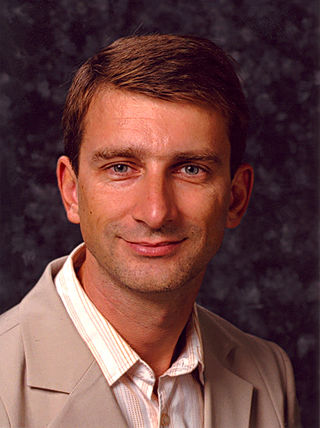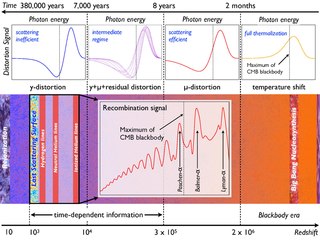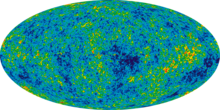Newtonian cosmological simulation codes
GADGET
GADGET, named "GAlaxies with Dark matter and Gas intEracT" is a code written in C++ for cosmological N-body/Smoothed-particle hydrodynamics (SPH) simulations on massively parallel computers with distributed memory. [15] Its first version was developed by German astrophysicist, Volker Springel and was published in 2000. [16] It was followed by two more official public versions, with GADGET-2 [17] [18] released in 2005 and GADGET-4 [19] [20] released in 2020, which is the most recent public version of the software suite currently. GADGET is capable to address a wide array of astrophysically interesting problems, e.g. the dynamics of the gaseous intergalactic medium, star formation and its regulation by feedback processes, colliding and merging galaxies, as well as the formation of large-scale structure in the Universe.
AREPO
AREPO [21] [22] is a massively parallel code for gravitational N-body systems, hydrodynamics and magnetohydrodynamics (MHD). It is named after the enigmatic word AREPO in the Latin palindromic sentence "sator arepo tenet opera rotas", the Sator Square. The first version of AREPO was written and published by Volker Springel in 2010, with further development by Rüdiger Pakmor and contributions by many other authors. The Arepo code utilizes an unstructured Voronoi-mesh and was designed to blend the benefits of finite-volume hydrodynamics and SPH. Primarily optimized for cosmological simulations, especially galaxy formation, Arepo supports a high dynamic range in space and time. [23]
GIZMO
GIZMO [24] is a flexible, massively parallel, multi-physics simulation code, written in ANSI C by Philip F. Hopkins. The code offers diverse methods to solve fluid equations. It also introduces novel methods, which optimize the resolution of simulations and minimize common errors found in previous methods that limited the accuracy of prior solvers. Originating from GADGET (hence the name "GIZMO", a play on words), the code maintains compatibility in naming/use conventions as well as input/output, making it user-friendly for those familiar with GADGET. [25]
StePS
StePS, [26] [27] which stands for "STEreographically Projected cosmological Simulations" is a freely available code that implements a novel N-body simulation method that models an infinite universe within a finite sphere with isotropic boundary conditions to follow the evolution of the large-scale structure. Unlike traditional methods, which use unrealistic periodic boundary conditions for numerical simplicity, StePS offers a more observation-aligned approach. This technique enables detailed simulations of an infinite universe using less memory and provides results that are more in line with the observed universe geometry and topology. [28]

The cosmic microwave background is microwave radiation that fills all space in the observable universe. It is a remnant that provides an important source of data on the primordial universe. With a standard optical telescope, the background space between stars and galaxies is almost completely dark. However, a sufficiently sensitive radio telescope detects a faint background glow that is almost uniform and is not associated with any star, galaxy, or other object. This glow is strongest in the microwave region of the radio spectrum. The accidental discovery of the CMB in 1965 by American radio astronomers Arno Penzias and Robert Wilson was the culmination of work initiated in the 1940s.
In physics, quintessence is a hypothetical form of dark energy, more precisely a scalar field, postulated as an explanation of the observation of an accelerating rate of expansion of the universe. The first example of this scenario was proposed by Ratra and Peebles (1988) and Wetterich (1988). The concept was expanded to more general types of time-varying dark energy, and the term "quintessence" was first introduced in a 1998 paper by Robert R. Caldwell, Rahul Dave and Paul Steinhardt. It has been proposed by some physicists to be a fifth fundamental force. Quintessence differs from the cosmological constant explanation of dark energy in that it is dynamic; that is, it changes over time, unlike the cosmological constant which, by definition, does not change. Quintessence can be either attractive or repulsive depending on the ratio of its kinetic and potential energy. Those working with this postulate believe that quintessence became repulsive about ten billion years ago, about 3.5 billion years after the Big Bang.
In modern physical cosmology, the cosmological principle is the notion that the spatial distribution of matter in the universe is uniformly isotropic and homogeneous when viewed on a large enough scale, since the forces are expected to act equally throughout the universe on a large scale, and should, therefore, produce no observable inequalities in the large-scale structuring over the course of evolution of the matter field that was initially laid down by the Big Bang.
The Sunyaev–Zeldovich effect is the spectral distortion of the cosmic microwave background (CMB) through inverse Compton scattering by high-energy electrons in galaxy clusters, in which the low-energy CMB photons receive an average energy boost during collision with the high-energy cluster electrons. Observed distortions of the cosmic microwave background spectrum are used to detect the disturbance of density in the universe. Using the Sunyaev–Zeldovich effect, dense clusters of galaxies have been observed.
The Lambda-CDM, Lambda cold dark matter, or ΛCDM model is a mathematical model of the Big Bang theory with three major components:
- a cosmological constant denoted by lambda (Λ) associated with dark energy
- the postulated cold dark matter denoted by CDM
- ordinary matter

The Very Small Array (VSA) was a 14-element interferometric radio telescope operating between 26 and 36 GHz that is used to study the cosmic microwave background radiation. It was a collaboration between the University of Cambridge, University of Manchester and the Instituto de Astrofisica de Canarias (Tenerife), and was located at the Observatorio del Teide on Tenerife. The array was built at the Mullard Radio Astronomy Observatory by the Cavendish Astrophysics Group and Jodrell Bank Observatory, and was funded by PPARC. The design was strongly based on the Cosmic Anisotropy Telescope.
In physical cosmology, CMBFAST is a computer code, written by Uroš Seljak and Matias Zaldarriaga, for computing the anisotropy of the cosmic microwave background. It was the first efficient program to do so, reducing the time taken to compute the anisotropy from several days to a few minutes by using a novel semi-analytic line-of-sight approach.

GADGET is free software for cosmological N-body/SPH simulations written by Volker Springel at the Max Planck Institute for Astrophysics. The name is an acronym of "GAlaxies with Dark matter and Gas intEracT". It is released under the GNU GPL. It can be used to study for example galaxy formation and dark matter.

Archeops was a balloon-borne instrument dedicated to measuring the Cosmic microwave background (CMB) temperature anisotropies. The study of this radiation is essential to obtain precise information on the evolution of the Universe: density, Hubble constant, age of the Universe, etc. To achieve this goal, measurements were done with devices cooled down at 100mK temperature placed at the focus of a warm telescope. To avoid atmospheric disturbance the whole apparatus is placed on a gondola below a helium balloon that reaches 40 km altitude.

The CMB Cold Spot or WMAP Cold Spot is a region of the sky seen in microwaves that has been found to be unusually large and cold relative to the expected properties of the cosmic microwave background radiation (CMBR). The "Cold Spot" is approximately 70 µK (0.00007 K) colder than the average CMB temperature, whereas the root mean square of typical temperature variations is only 18 µK. At some points, the "cold spot" is 140 µK colder than the average CMB temperature.
Conformal cyclic cosmology (CCC) is a cosmological model in the framework of general relativity and proposed by theoretical physicist Roger Penrose. In CCC, the universe iterates through infinite cycles, with the future timelike infinity of each previous iteration being identified with the Big Bang singularity of the next. Penrose popularized this theory in his 2010 book Cycles of Time: An Extraordinary New View of the Universe.

Uroš Seljak is a Slovenian cosmologist and a professor of astronomy and physics at University of California, Berkeley. He is particularly well-known for his research in cosmology and approximate Bayesian statistical methods.
In cosmology, decoupling is a period in the development of the universe when different types of particles fall out of thermal equilibrium with each other. This occurs as a result of the expansion of the universe, as their interaction rates decrease up to this critical point. The two verified instances of decoupling since the Big Bang which are most often discussed are photon decoupling and neutrino decoupling, as these led to the cosmic microwave background and cosmic neutrino background, respectively.
Minicharged particles are a proposed type of subatomic particle. They are charged, but with a tiny fraction of the charge of the electron. They weakly interact with matter. Minicharged particles are not part of the Standard Model. One proposal to detect them involved photons tunneling through an opaque barrier in the presence of a perpendicular magnetic field, the rationale being that a pair of oppositely charged minicharged particles are produced that curve in opposite directions, and recombine on the other side of the barrier reproducing the photon again.

The Cosmology Large Angular Scale Surveyor (CLASS) is an array of microwave telescopes at a high-altitude site in the Atacama Desert of Chile as part of the Parque Astronómico de Atacama. The CLASS experiment aims to improve our understanding of cosmic dawn when the first stars turned on, test the theory of cosmic inflation, and distinguish between inflationary models of the very early universe by making precise measurements of the polarization of the Cosmic Microwave Background (CMB) over 65% of the sky at multiple frequencies in the microwave region of the electromagnetic spectrum.
The Illustris project is an ongoing series of astrophysical simulations run by an international collaboration of scientists. The aim was to study the processes of galaxy formation and evolution in the universe with a comprehensive physical model. Early results were described in a number of publications following widespread press coverage. The project publicly released all data produced by the simulations in April, 2015. Key developers of the Illustris simulation have been Volker Springel and Mark Vogelsberger. The Illustris simulation framework and galaxy formation model has been used for a wide range of spin-off projects, starting with Auriga and IllustrisTNG followed by Thesan (2021), MillenniumTNG (2022) and TNG-Cluster (2023).

The Atacama B-Mode Search (ABS) was an experiment to test the theory of cosmic inflation and distinguish between inflationary models of the very early universe by making precise measurements of the polarization of the Cosmic Microwave Background (CMB). ABS was located at a high-altitude site in the Atacama Desert of Chile as part of the Parque Astronómico de Atacama. ABS began observations in February 2012 and completed observations in October 2014.
The "axis of evil" is a name given to the apparent correlation between the plane of the Solar System and aspects of the cosmic microwave background (CMB). It gives the plane of the Solar System and hence the location of Earth a greater significance than might be expected by chance – a result which has been claimed to be evidence of a departure from the Copernican principle as assumed in the concordance model.
In cosmological inflation, within the slow-roll paradigm, the Lyth argument places a theoretical upper bound on the amount of gravitational waves produced during inflation, given the amount of departure from the homogeneity of the cosmic microwave background (CMB).

CMB spectral distortions are tiny departures of the average cosmic microwave background (CMB) frequency spectrum from the predictions given by a perfect black body. They can be produced by a number of standard and non-standard processes occurring at the early stages of cosmic history, and therefore allow us to probe the standard picture of cosmology. Importantly, the CMB frequency spectrum and its distortions should not be confused with the CMB anisotropy power spectrum, which relates to spatial fluctuations of the CMB temperature in different directions of the sky.










